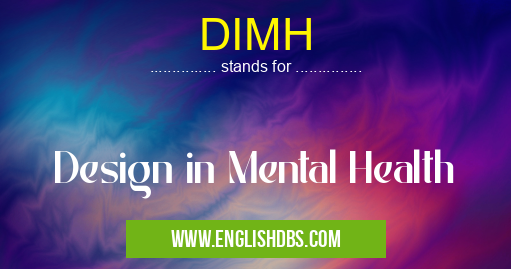What does DIMH mean in HEALTHCARE
DIMH stands for Design in Mental Health, which refers to a field of health research and development focused on the use of design thinking and design tools to improve mental healthcare. This approach applies widely applicable principles of design to the problems faced by people with mental health issues. It seeks to identify solutions, develop interventions, and provide support to those affected by mental health problems.

DIMH meaning in Healthcare in Medical
DIMH mostly used in an acronym Healthcare in Category Medical that means Design in Mental Health
Shorthand: DIMH,
Full Form: Design in Mental Health
For more information of "Design in Mental Health", see the section below.
» Medical » Healthcare
Essential Questions and Answers on Design in Mental Health in "MEDICAL»HEALTHCARE"
What is the purpose of Design in Mental Health?
The purpose of Design in Mental Health is to improve the quality of care available for people suffering from mental health issues by applying widely applicable principles of design to the problems they face. Through this approach, solutions can be identified, developed interventions established, and ongoing support provided.
How does Design in Mental Health differ from other approaches that address mental health issues?
Design in Mental Health approaches the issue from a human-centered viewpoint that combines design principles with mental health expertise to create tailored solutions that are proven effective. This approach differs from a strictly medical or therapeutic model because it takes into account external social factors as well as individual circumstances when formulating solutions.
What are some of the benefits offered by Design in Mental Health?
Some of the major benefits offered by this approach include improved understanding of underlying root causes leading to better diagnosis and treatment plans; more effective communication between patients and their healthcare teams; better accessibility and engagement with therapy options; improved patient experience; and reduced incidence of burnout among professionals working in this field.
Are there any challenges associated with implementing Design in Mental Health?
Yes, there are several important challenges associated with implementing this approach. These include identifying funding sources for new initiatives; developing guidelines for consistent standards across different venues; setting up processes for evaluating success; addressing cultural biases related to treatments and perceptions about mental illness; ensuring access to high-quality services for all demographics; providing sufficient levels of training for both professionals and patients/families/caregivers.
How can I get involved in advancing Design in Mental Health efforts?
Organizations around the world have formed working groups dedicated to advancing these efforts through research initiatives, policy reform, educational campaigns, pilot projects, advocacy work, fundraising activities, media campaigns etc. Those who are interested can contact these organizations directly or look out for volunteer opportunities where they can contribute their skillsets towards improving outcomes within this field.
Final Words:
Design in Mental Health represents an exciting opportunity for making progress towards healthier mental lives around the world — incorporating design elements into our understanding and application of care has already begun yielding positive results. By actively engaging with initiatives related to DIMH through research or practical implementation we can continue pushing forward towards a future where optimal mental wellbeing is possible regardless of individual circumstance or background.
